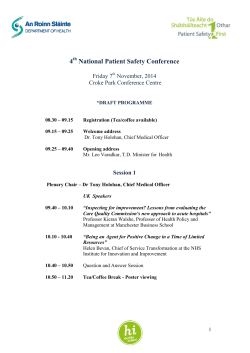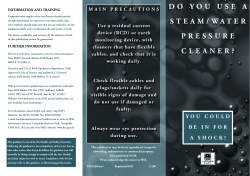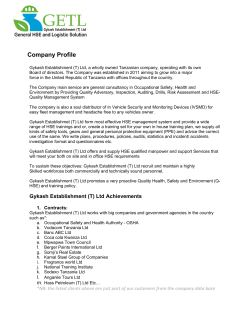
Health and safety in manufacturing in Great Britain, 2014 Contents
Health and Safety Executive Health and safety in manufacturing in Great Britain, 2014 Contents Summary 2 What is manufacturing? 3 Economic context 3 Ill health 5 Overall, musculoskeletal disorders and stress 5 Skin, respiratory and other disorders 6 Occupational Cancer 7 Injuries 8 Overview 8 Fatal injuries 8 Major/specified injuries 9 Over-three-day and over-seven-day injuries 11 Labour Force Survey (LFS) injuries and days lost 12 Occupations 12 Estimated costs to Britain 12 Enforcement 13 Links to data sources and tables 14 This document is available from www.hse.gov.uk/statistics/ Page 1 of 15 Summary The information in this document relates to Health and Safety Statistics for 2013/14. The document can be found at www.hse.gov.uk/statistics/industry/manufacturing/ In 2013/14 manufacturing accounted for around 10% of both the British workforce, and of fatalities. However, nearly one in five (18%) reported non-fatal injuries to employees were in manufacturing. There have been reductions in injury and ill health rates over the past decade. More recently, however, rates seem to be flattening out – see Figure 1. The latest results (2013/14) in manufacturing show: there were 14 fatal injuries to workers compared to an average of 26 in the previous five years – less than a quarter (23%) of the number 20 years ago (RIDDOR); there were 13 595 reported non-fatal injuries to employees and an estimated 74 thousand cases of all self-reported injuries. (RIDDOR and LFS); about 14% of reported major/specified injuries and 11% of over-seven-day injuries involved contact with moving machinery (RIDDOR); food manufacture had the highest number of major/specified injuries, with a rate of reported injury more than twice that of manufacturing as a whole (RIDDOR); about two thousand occupational cancer deaths each year resulted from past exposures in the manufacturing sector (Cancer Burden Study, 2010); an estimated 3.7 million working days were lost, 2.6 million due to ill health and 1.1 million due to injury, making a total of 1.4 days lost per worker (LFS). Figure 1 Numbers of fatal injuries to employees (RIDDOR) 1974 to 2013/14p This document is available from www.hse.gov.uk/statistics/ Page 2 of 15 What is manufacturing? HSE uses the SIC 2007 1 classification scheme to define industries. Under SIC 2007, manufacturing (Section C) includes: Industry / Manufacture of Food products Beverages Tobacco products Textiles Wearing apparel Leather and related products Wood and products of wood and cork, except furniture; articles Paper and paper products Printing and reproduction of recorded media Coke and refined petroleum products Chemicals and chemical products Basic pharmaceutical products and pharmaceutical preparations Rubber and plastic products Other non-metallic mineral products Basic metals Fabricated metal products, except machinery and equipment Computer, electronic and optical products Electrical equipment Machinery and equipment n.e.c. Motor vehicles, trailers and semi-trailers Other transport equipment Furniture Other manufacturing Repair and installation of machinery and equipment Division 10 11 12 13 14 15 16 17 18 19 20 21 22 23 24 25 26 27 28 29 30 31 32 33 Motor vehicle repair (MVR) is included in wholesale and retail trade; repair of motor vehicles and motorcycles, not in manufacturing. However, a few references are included, because of the links with manufacturing. Economic context The Office for National Statistics estimates that manufacturing output increased by 3.6% between Q2 2013 and Q2 2014 2 . However, manufacturing output was still 4.4% below the pre-downturn peak in Q1 2008. Main changes 3 , compared with a year ago, were in manufacture of: Change rubber, plastic products & other non-metallic mineral products 10.6% transport equipment 3.5% basic metals & metal products 4.1% coke & refined petroleum products 14.6% textiles, wearing apparel & leather product 6.3% electrical equipment 4.1% 1 www.ons.gov.uk/ons/guide-method/classifications/current-standard-classifications/standard-industrial-classification/index.html www.ons.gov.uk/ons/dcp171778_376723.pdf page 36. 3 Index of Production - www.ons.gov.uk/ons/dcp171778_376429.pdf page 11. See also www.ons.gov.uk/ons/dcp171778_379451.pdf 2 This document is available from www.hse.gov.uk/statistics/ Page 3 of 15 Figure 2 GDP and main components relative to 2008 Q1 level Source: Office for National Statistics 4 4 www.ons.gov.uk/ons/dcp171778_376723.pdf page 10 This document is available from www.hse.gov.uk/statistics/ Page 4 of 15 Ill health Overall, musculoskeletal disorders and stress According to the Labour Force Survey in 2013/14 an estimated 87 000 people whose current or most recent job in the last year was in the manufacturing sector suffered from an illness (longstanding and new cases) which was caused or made worse by this job (WRIIND2). The associated rate, 2 880 (2.9%) per 100 000 people working in the last year, was not statistically significantly lower than the average for all industries (3 990 per 100 000 – 4.0%). Examining the rates for total cases (longstanding and new cases) using smoothing techniques, which aim to reduce irregularities (random fluctuations) in the time series, suggests a downward trend. The smooth trend indicates a fall of around 31% between 2001/02 and 2013/14, with a range of possibilities (95% confidence interval) 20% to 42%. Table 1 Ill health data sources and latest figures Health issue THOR – estimated rate of new cases of work-related illness per 100 000 persons (2013 and 3 year average 2011 to 2013) LFS – estimated rate of new cases of self-reported illness per 100 000 employed in the last 12 months (3 year average 201011, 2011/12, 2013/14) Work-related ill health (Table THORGP04) 1 160 (Table WRIIND4_3YR). Higher than the rate for all industries. This is statistically significantly lower than the all industry rate of 1 460. There were an estimated 34 000 new cases of illness caused or made worse by a current or most recent job. 1.4 times the rate for all industries in 2013. 1.5 times the rate for all industries averaged over three years. Work-related musculoskeletal disorders (THORGP05). 450 (MSDIND4_3YR) Higher than the rate for all industries. Not statistically significantly different from the all industry rate (480). 1.6 times the rate for all industries in 2013. 1.7 times the rate for all industries averaged over three years. Mental ill-health/selfreported stress, depression or anxiety (THORGP06), 440 (STRIND4_3YR) Lower than the rate for all industries. This is statistically significantly lower than the all industry rate (670). 0.8 times the rate for all industries in 2013. 0.9 times the rate for all industries averaged over three years. The values quoted above are the central estimates from the LFS survey. The respective tables include the confidence interval (an indicator of the reliability) for each estimate. This document is available from www.hse.gov.uk/statistics/ Page 5 of 15 The Labour Force Survey (LFS) and voluntary reporting of occupational diseases by doctors (THOR and THOR-GP) provide data about health risks in different industries and occupations. When comparing results, however, it is important to understand that cases reported under THOR have been diagnosed by doctors while those reported under LFS are cases of self-reported illness caused or made worse by current or most recent job for people working in the last 12 months. Additional data, for example, for previous years may be found in the various tables. An estimated total of 2.6 million working days, or 0.99 days per worker, were lost in 2013/14 due to selfreported work-related illness (Table WDLIND, but see also WRIIND6_3YR). This is similar (not significantly different) to that of 0.83 days per worker for all industries. The estimated time lost due to illness is over twice that lost due to injury. Figure 3 Estimated rates of total cases of self-reported work-related illness caused or made worse by their current or most recent job for people working in the last 12 months (LFS) Skin, respiratory and other disorders 5 From THOR, between 2008 and 2013p, the estimated average rate per 100 000 persons in manufacturing of contact dermatitis reported by dermatologists to EPIDERM was six compared with four for all industries (THORS05). However, there is substantial variation within manufacturing: manufacture of chemicals had a rate of 18; manufacture of basic metals – 13; printing and reproduction of recorded media – 11. Both THOR and the IIDB scheme figures continue to implicate isocyanates and flour/grain as responsible for a high proportion of new cases of occupational asthma. Cutting oils and coolants, wood dusts and welding fumes are also significant factors. These agents are all common in different parts of manufacturing and motor vehicle repair. Airborne materials from spray painting or manufacturing foam product; dusts from flour or grain/cereal; airborne materials while welding, soldering or cutting/grinding metals; dusts from stone, cement, brick or concrete were all significant causes of "breathing or lung problems". Again these are common in parts of manufacturing. The parts of manufacturing with the largest number of reports were ship building/repair and basic iron/steel/ferro-alloy manufacture. (www.hse.gov.uk/statistics/causdis/respiratory-diseases.pdf) The rate of new assessments of cases of vibration white finger under IIDB, averaged across the three years from 2011 to 2013, was 5.9 per 100 000 workers in manufacturing, compared to 1.2 across all sectors. Manufacturing had had very high rates of all IIDB prescribed diseases compared to the all-industry rates. For example: the rate of carpal tunnel syndrome was 4.5 per 100 000 compared to 0.9 across all sectors; of occupational deafness was 4.1 compared to 0.5; of asthma was 3.2 compared to 0.4. (IIDB10) 5 For a discussion of the sources used in producing HSE Statistics, see www.hse.gov.uk/statistics/sources.htm. This document is available from www.hse.gov.uk/statistics/ Page 6 of 15 Occupational Cancer About a quarter of occupational cancer registrations and deaths are attributable to occupational carcinogen exposure in the manufacturing industry. There are around 2 200 deaths and 3,900 registrations that are attributed to the past exposure to occupational carcinogens (eg substance or occupational circumstance) each year. Past exposure to mineral oils and asbestos have contributed to a large proportion of the current burden of occupational cancer, accounting for 17% of registrations and 13% of deaths respectively for all industries. Dioxins and silica are significant occupational carcinogens. Past exposure to shift work and working as a welder or painter are also significant contributors to the current burden of occupational cancer. (CAN04 and CAN05) Further information is available from our cancer page or from research report 931 “The burden of occupational cancer in Great Britain.” 6 6 www.hse.gov.uk/research/rrhtm/rr800.htm This document is available from www.hse.gov.uk/statistics/ Page 7 of 15 Injuries7 Overview Manufacturing accounts for about one in ten British employees, but almost one in five of reported injuries to employees (10% fatalities, 17% major/specified, 18% over-seven-day) in 2013/14p. The Labour Force Survey (LFS) estimates that around 15% of all reportable non-fatal injuries occurred in Manufacturing, based on three-year average 2011/12 to 2013/14. Fatal injuries In 2013/14p there were 14 fatal injuries to workers, compared to an average of 26 in the previous five years. This equates to a fatal injury rate of 0.5 per 100 000 workers. This is also lower than the average rate of 0.9 per 100 000 workers for the previous five years. Figure 4 Number and rate of fatal injuries to workers in manufacturing (RIDDOR) There were about eight times as many employee fatal injuries in the first five years after the Health and Safety at Work Act 1974 (1975 to 1979, average 174) as in the most recent five years (2009/10 to 2013/14p, average 21). Over the past 40 years, manufacturing employees’ fatal injury rates have fallen to a quarter of their 1974 level. (Figure 1 page 2). Manufacture of food and of fabricated metal products accounted for three each of the fourteen worker fatalities in 2013/14p. Over the five years from 2009/10 to 2013/14p, these two industries had most fatal injuries. The main causes of worker fatalities were: Table 2 Kinds of fatal injuries to workers, 2009/10 - 2013/14p % of fatal injuries in manufacturing, % of fatal injuries in all industries Struck by object 27% 14% Contact with machinery 15% 8% Fall from height 15% 25% Trapped by something collapsing 8% 9% Struck by moving vehicle 7% 14% Exposed to fire 5% 1% 11% 14% Kind of injury Another kind of accident not listed on RIDDOR form 7 In 2011/12, the RIDDOR reporting system changed. There were also changes to what injuries had to be reported in 2012/13 (over 3 to over 7 day absence) and mid-way through 2013/14 (from major to specified injuries). www.hse.gov.uk/statistics/sources.htm#riddor provides further explanation). This document is available from www.hse.gov.uk/statistics/ Page 8 of 15 Major/specified injuries In 2013/14p, there were 3 159 reported major/specified injuries to employees – a rate of 120.8 per 100 000 employees. In the previous five years there were an average of 3 737 major injuries with a rate of 139.1 per 100 000 employees. The general downward long-term trend in both the numbers and rates may be levelling off. Figure 5 Number and rate of major/specified injuries to employees in manufacturing (RIDDOR) Major & Specified Major The main causes of reported major/specified injury to employees included: Table 3 Kinds of major/specified injury to employees Manufacturing 2013/14p Manufacturing 2009/10 to 2013/14p All industries 2009/10 to 2013/14p Slip, trip, fall same level 29% 30% 41% Contact with machinery 14% 15% 4% Struck by object 13% 15% 11% Lifting and handling injuries 11% 13% 10% Fall from height 13% 12% 15% This document is available from www.hse.gov.uk/statistics/ Page 9 of 15 Excluding the general category of “Other manufacturing”, Manufacture of wood/wood products and food products have the highest rates of major/specified injuries (298.0 and 230.5, averaged between 2009/10 and 2013/14p). Food manufacture has the largest number of reported major/specified injuries (693 per year, on average). Fabricated metal products had the next largest number (457). These two industries accounted for 33% of reported major/specified injuries in manufacturing. Figure 6 Manufacturing industries with major/specified injury rates above 100 per 100 000 employees, 2009/10 – 2013/14p combined (RIDDOR, excluding unspecified manufacturing) This document is available from www.hse.gov.uk/statistics/ Page 10 of 15 Over-three-day and over-seven-day injuries In 2013/14p, there were 10 436 reported over-seven-day injuries to employees – a rate of 399.0 per 100 000 employees. Over the previous five years there were an average number of 14 227 over-three/over-7-day’s absence injuries, with a rate of 529.7 over-three/over-7-day’s absence. Figure 7 Manufacturing industries with rates of absence injury above 500 per 100 000 employees, 2009/10 to 2013/14p combined (RIDDOR, excluding unspecified manufacturing) As with major/specified injuries, rates for reported over-seven-day injuries vary widely between different manufacturing industries. Manufacture of food products had a rate of 925.3 per 100 000 employees in 2013/14p. Manufacture of food products also had the highest number of reported over-seven-day injuries (2 886). The change from over-three-day to over-seven-day reporting makes it difficult to judge if there has been a reduction in the number and rate of non-fatal non-major injuries. Analysis indicates that the trend in the overthree/seven-day injury rate may be beginning to flatten out, following a period of sustained reduction. See www.hse.gov.uk/statistics/causinj/over-7-day-adjust.htm for further information and a longer-term quarterly series of over-three/seven-day injury reports. The main causes of reported over-seven-day injury to employees included: Table 4 Kinds of over-seven-day and over-three-day injury to employees Manufacturing 2013/14p Manufacturing 2009/10 to 2013/14p All industries 2009/10 to 2013/14p Lifting and handling injuries 30% 33% 33% Slip, trip, fall same level 18% 19% 24% Struck by object 12% 13% 10% Contact with machinery 11% 11% 3% This document is available from www.hse.gov.uk/statistics/ Page 11 of 15 Labour Force Survey (LFS) injuries and days lost Results from the Labour Force Survey (averaged over 2011/12 to 2013/14) showed: manufacturing sector had statistically significantly higher rates for all non-fatal injuries than for all industries; the manufacturing sector accounted for around 17% of over-7-day absence injuries; the estimated rate of over-seven-day absence injury was 850 per 100 000 workers (0.85%). This was statistically significantly higher than the corresponding average rate of 500 per 100 000 workers (0.52%) across all industries (INJIND4_3YR); and there were an estimated 74 thousand cases of all self-reported workplace non-fatal injury per year (INJIND3_3YR). In 2013/14 the estimated total number of working days lost (full-day equivalent) due to workplace injury attributed to the current or most recent job was about 1.14 million equating to 0.43 days per worker. The estimated average rate for all industries was 0.17 days per worker. This was not statistically significantly different to the average across all industries. (WDLIND, but see also INJIND2_3YR). Occupations The risk of injury also varies significantly with occupation. Results from the Labour Force Survey showed: process, plant and machine operatives had an estimated rate of over-seven-day absence injury of 1 090 per 100 000 workers or about 1% of the workforce per year. (INJOCC4_3YR – averaged 2011/12 to 2013/14). The average rate across all occupations was 500 and the injury rate for process, plant and machine operatives is statistically significantly higher; process, plant and machine operatives lost half a working day (0.53) per year due to self-reported workplace injury. The average lost time per worker across all occupations was 0.18 working days (INJOCC2_3YR – averaged 2010/11 to 2013/14). Estimated costs to Britain Workplace injury and work-related ill health impose costs on employers (e.g. sick pay), on individuals (e.g. the human costs of pain, grief and suffering), and on the Government (e.g. health care expenditure). Latest GB estimates show that injuries and new cases of ill health resulting largely from current working conditions 8 in workers in manufacturing cost society an estimated £1.4 billion, in 2012/13 (expressed in 2012 prices). Figure 8 Cost to Britain of workplace injury and work-related ill health in the manufacturing industry 2012/13 (in 2012 prices) 8 Further work continues to estimate the cost of work-related conditions, such as cancer, caused by historic conditions. See www.hse.gov.uk/statistics/enforcement.htm 9 This document is available from www.hse.gov.uk/statistics/ Page 12 of 15 Enforcement9 HSE and local authorities are responsible for enforcing health and safety legislation. Each has a range of tools at their disposal in seeking to secure compliance with the law and ensure a proportionate response to offences. For more serious offences, inspectors may serve improvement notices and prohibition notices and they may prosecute (or in Scotland, report to the Procurator Fiscal with a view to prosecution). In 2013/14p the number of cases heard was 8% lower than the average for the previous 3 years. Nearly 95% of cases resulted in a conviction. Figure 9 Prosecutions in manufacturing 10 350 £40 000 300 £35 000 £30 000 250 £25 000 200 £20 000 150 £15 000 100 £10 000 50 £5 000 £ 09/10 10/11 11/12 12/13 13/14 Cases prosecuted Offences prosecuted Average fine per case Average fine per offence Figure 10 Enforcement notices in manufacturing 9 See www.hse.gov.uk/statistics/enforcement.htm Case refers to a prosecution against a single defendant. The defendant may be an individual person or a company. There may be one or more breaches of health and safety legislation (offences) in each case. 10 This document is available from www.hse.gov.uk/statistics/ Page 13 of 15 Links to data sources and tables Tables Web Address (URL) RIDIND www.hse.gov.uk/statistics/ltables/ridind.xls INJIND1_3YR www.hse.gov.uk/statistics/lfs/injind1_3yr.xls INJIND2_3YR www.hse.gov.uk/statistics/lfs/injind2_3yr.xls INJOCC2_3YR www.hse.gov.uk/statistics/lfs/injocc2_3yr.xls INJOCC3_3YR www.hse.gov.uk/statistics/lfs/injocc3_3yr.xls INJIND3_3YR www.hse.gov.uk/statistics/injid3_3yr.xls INJIND4_3YR www.hse.gov.uk/statistics/injind4_3yr.xls MSDIND2_3YR www.hse.gov.uk/statistics/lfs/msdind2_3yr.xls MSDIND4_3YR www.hse.gov.uk/statistics/lfs/msdind4_3yr.xls STRIND4_3YR www.hse.gov.uk/statistics/lfs/strind4_3yr.xls WRIOCC6_3YR www.hse.gov.uk/statistics/lfs/wriocc6_3yr.xls WRIIND2_3YR www.hse.gov.uk/statistics/lfs/wriind2_3yr.xls WRIIND4_3YR www.hse.gov.uk/statistics/lfs/wriind4_3yr.xls WRIIND6_3YR www.hse.gov.uk/statistics/lfs/wriind6_3yr.xls WDLIND www.hse.gov.uk/statistics/lfs/wdlind.xls THORGP04 www.hse.gov.uk/statistics/tables/thorgp04.xls THORGP05 www.hse.gov.uk/statistics/tables/thorgp05.xls THORGP06 www.hse.gov.uk/statistics/tables/thorgp06.xls THORS04 www.hse.gov.uk/statistics/tables/thors04.xls THORS05 www.hse.gov.uk/statistics/tables/thors05.xls THORR01 www.hse.gov.uk/statistics/tables/thorr01.xls THORR04 www.hse.gov.uk/statistics/tables/thorr04.xls Other tables www.hse.gov.uk/statistics/tables/index.htm This document is available from www.hse.gov.uk/statistics/ Page 14 of 15 National Statistics National Statistics are produced to high professional standards set out in the National Statistics Code of Practice. They undergo regular quality assurance reviews to ensure that they meet customer needs. They are produced free from any political interference. An account of how the figures are used for statistical purposes can be found at www.hse.gov.uk/statistics/sources.htm. For information regarding the quality guidelines used for statistics within HSE see www.hse.gov.uk/statistics/about/quality-guidelines.htm A revisions policy and log can be seen at www.hse.gov.uk/statistics/about/revisions/ Additional data tables can be found at www.hse.gov.uk/statistics/tables/ Statistician: Stephen Wright Contact: stephen.cosas.wright@hse.gsi.go.uk Last updated: October 2014 Next update: October 2015 © Crown copyright If you wish to reuse this information visit www.hse.gov.uk/copyright.htm for details. First published 10/14. Published by the Health and Safety Executive V1 10/14
© Copyright 2025










